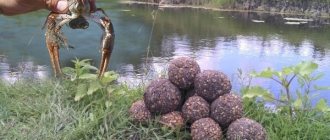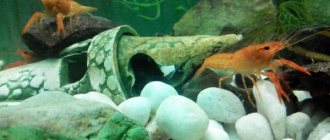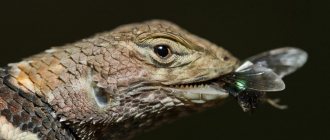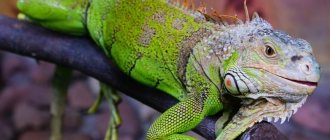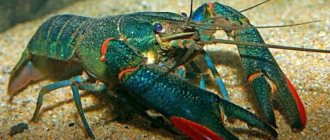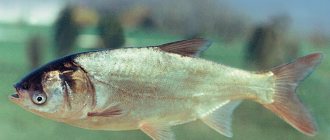Often when breeding crayfish, the question arises as to what crustaceans eat. Feeding crayfish is a responsible process that requires a serious approach. After all, their immunity, taste and further development depend on what arthropods eat. You cannot feed crayfish with any food. The article covers all the points related to feeding crayfish.
Peculiarities of crayfish nutrition during home breeding
You need to create a diet after determining the place where you plan to keep the crayfish.
In the pond
In a reservoir, arthropods consume natural food. These are plants, daphnia, small worms, rotifers. You should not rely on this menu being enough for the rapid development and reproduction of your wards. In any case, additional feeding will be required, otherwise the profit from the business will be insignificant.
To achieve marketable weight and size, crayfish are fed by installing feeders in the pond. They are preliminarily filled with pieces of bread, fish meat, vegetables, and oil production waste. In the evening, filled feeders are lowered to the bottom of the reservoir. Too much food should not be served; the leftovers will begin to decompose in the water, causing the environment to become polluted. This can cause the death of pond inhabitants.
Reference! To feed arthropods in the pond, you can use spinach leaves, soaked cereal grains, dandelions, lettuce and other garden crops.
The feeding period for invertebrates in the reservoir is from March to the second half of September or the first ten days of October. The timing is determined taking into account the water temperature. It should be about 10 degrees. When the temperature drops, feeding stops.
The daily ration rate is 0.5% of the live weight of the wards. In winter, there is enough food in the reservoir. Therefore, fertilizing is not carried out until spring.
In aquariums
When keeping arthropods in pools or an aquarium, you need to create a diet in such a way that it is as close as possible to the diet in the natural environment.
Specialized stores offer a large selection of food:
- pills;
- sinking granules;
- cereals, etc.
When choosing feed, preference is given to formulations enriched with calcium. This microelement promotes the rapid restoration of chitinous cover after a period of molting. You need to dilute the menu with spinach, cucumbers, and zucchini. If aquatic plants grow in the aquarium, the excess is also given to the crayfish as a treat.
Reference! At least once a week, fish fillets, shrimp or other frozen food should be added to the arthropod diet. This is a protein food necessary for rapid growth and weight gain.
The feeding regime in the aquarium is the same as in the pond - once a day. To create optimal conditions for keeping invertebrates, breeders equip the bottom of the tank with various stones and pots so that the crayfish can find shelter. On the one hand, this is correct, because adult individuals often arrange brutal fights among themselves. The victim has a chance to escape pursuit by hiding in a gorge of stones. On the other hand, food debris accumulates in secluded places, which speeds up the process of polluting the aquarium.
Diet during molting period
Molting is common for crayfish. Crustaceans grow throughout their entire life; due to the chitinous cover, this is not possible, because it is hard. Cancer needs it to be reset regularly. During molting, arthropods lose their activity and spend most of their time in shelter. If, instead of cancer, only its shell was seen, do not be alarmed, this is a natural process.
The chitinous cover is not removed - the cancer will eat it. After molting, young crayfish require a lot of calcium, which contributes to the rapid restoration of a new coating. In the first stages of their life, arthropods molt 5-6 times. After a few years, molting occurs several times throughout the year. The process itself lasts only 2-3 minutes. The new cover is completely restored in 1-1.5 weeks.
Before molting, it is necessary to increase the volume or frequency of feeding by approximately 4 times. It is allowed to feed crayfish with specialized food.
It is recommended to feed the following foods:
- pasta;
- shrimps;
- carrot;
- fish;
- porridge;
- worms;
- snails;
- meat;
- bloodworm;
- tubifex;
- coretra;
- Daphnia;
- gammarus.
Arthropods will also like a diet consisting of cabbage, lettuce, peas, parsley, zucchini, nettles, spinach, frozen vegetables, tree leaves, and even dry food for aquarium fish.
What do crayfish eat?
Under natural conditions, arthropods quickly find food thanks to their acute sense of smell. As the food decomposes, a distinct odor is formed, to which the crayfish rush. They can find food without difficulty, despite poor eyesight.
In the river, the diet includes algae, which are rich in lime. Calcium oxide is essential for a healthy shell. It is especially important to consume calcium-containing foods during the molting period, when the old armor falls off and a new one is formed in its place.
Algae that contain large amounts of lime: elodea, hornwort, charophyte varieties.
The natural body of water is home to potential prey:
- cyclops;
- Daphnia;
- snails;
- worms;
- larvae;
- tadpoles.
When growing crayfish in the river, farms carry out activities to breed zoo- and phytoplankton. This is an excellent food not only for arthropods, but also for their prey.
Crayfish in an aquarium
At a certain point, every aquarium owner has a desire to make it special, add some zest, get an unusual pet... The choice of many falls on crayfish, and for good reason! Crayfish not only have an expressive appearance and often bright colors. Their behavior, lifestyle, anatomical features, even their method of movement - all this is a never-ending source of inspiration! It's always interesting to watch them.
Even a simple doggystyle technique is a breathtaking sight!
Cancer can regrow lost limbs, mustaches, even claws!
Tropical and American crayfish are suitable for life in an aquarium, for example:
- Florida (California);
- Cuban;
- Louisiana;
- Mexican;
- Australian;
- marble.
Cold-water crayfish from Russian reservoirs are not suitable for aquarium keeping.
Contrary to popular belief, crayfish can coexist with fish, under certain conditions.
Keeping such an unusual pet in an aquarium surprisingly does not bring any additional trouble. Well, or almost doesn’t bring it. We will tell you the main points of maintaining and caring for a home cancer. About their proximity to fish. And of course, about what and how they eat.
Diet
Stocking up on food for crayfish is not difficult. You can purchase it at a specialty store or prepare it yourself. The main thing is that the diet is as close as possible to the diet in the natural habitat.
Menu close to natural conditions
In a river or pond you can often see crayfish fighting for the carcass of a decomposing fish. The acute perception of a pronounced smell and red color should be taken into account when compiling a home menu. Crayfish can mistake cereals and red vegetables for a piece of meat. They perceive anything green as algae. But such a replacement is not a complete diet.
This is due to the low or lack of calcium in the proposed substitutes. River algae are rich in lime, which is necessary for arthropods to restore their hard shell after molting. Therefore, they should definitely be included in the menu.
In addition to algae, it is necessary to supplement the diet with living creatures living in natural reservoirs. These are insect larvae, worms, daphnia, cyclops, etc. It is also appropriate to include amphipods and fish of various breeds in the diet.
Artificial feeding
In the absence of the opportunity to make maximum use of natural food for crayfish, attention is paid to the choice of ready-made food, which can be easily purchased in the store.
Arthropods are nocturnal, so it is worth laying the feeder in the evening. The menu includes:
- boiled and raw vegetables;
- combined feeds intended for herbivorous fish;
- minced meat (meat, fish).
Fatty foods should not be used. It is completely useless for crayfish, but it will spoil the water in no time. This often ends in a pestilence of the inhabitants.
When artificial feeding, it is recommended to include in the menu:
- rotten fish;
- spoiled meat;
- soaked cereals;
- fresh vegetable trimmings;
- worms;
- pieces of bread;
- young frogs;
- bloodworm.
Crayfish love spoiled food, but such food quickly pollutes the water. Therefore, breeders give this delicacy no more than once a week. It is recommended to serve food in a feeder. This makes it easier to remove the leftovers.
Types of feed
Crayfish are omnivorous, with the exception of products with synthetic and chemical additives. Feed can be either industrial or self-prepared.
Self-cooking
When creating your own diet, remember to balance animal and plant foods. Homemade food for crayfish includes:
- pieces of raw meat, chicken, fish;
- earthworms, maggots, bloodworms;
- a variety of vegetables;
- nettle;
- bread;
- seaweed.
Do not give crayfish fatty foods, which will pollute the water.
Industrial manufacturing
Release form: flakes, granules of different sizes or sticks. Regardless of appearance, the food chosen should be:
- balanced;
- do not pollute water;
- contain elements that facilitate molting.
Some types of feed are formulated specifically for different stages of cancer's life. There are varieties of complementary foods to stimulate reproduction, enhance the color of the shell, and strengthen the immunity of the fry.
How to feed crayfish correctly
The process of feeding arthropods is carried out in compliance with the following rules:
- Feeders should be laid in the evening;
- adhere to the daily feed intake, which directly depends on the live weight of the wards;
- during the period of cuticle shedding or reproduction, the amount of food is increased for rapid recovery after high energy expenditure;
- if there is not enough food, the crayfish begin to attack each other;
- when arranging an aquarium or pond, you need to provide places for shelter;
- the daily diet of young animals exceeds the norm for adults;
- The diet for individuals of different sexes is set individually (females are fed 1 day every 3 days, males - 1 day every 2 days);
- the shed cuticle is not removed; arthropods eat it to enrich the body with valuable calcium.
Feeding the young
The growing body of young crayfish requires a larger volume of varied food.
Before reaching a length of 2 cm, they require detritus - a product of the breakdown of organic matter. In nature, at the bottom of a reservoir, it is quite enough for young individuals. Due to constant filtration, there is not enough detritus in the aquarium.
Dry leaves of oak, alder or beech are used as feed. Not only young crayfish eat them, but also adults. Add leaves as you eat them. Do not use fresh leaves. They are capable of releasing a dangerous toxin into the water. Two-centimeter crustaceans begin to eat various insect larvae. From three centimeters of height, shellfish are included in the diet. Having reached 4 cm, the crustaceans begin to eat small fish.
You can feed young fish at home using food intended for fish fry. Aquarists advise adding small daphnia to the diet. Before being introduced into the aquarium, daphnia is scalded with boiling water to reduce mobility.
Feeders
You should not throw food for the inhabitants of an aquarium or pond directly into the water. It's better to buy a feeder. The store offers a wide range of products that differ in size and shape. The main factor determining the choice is the absence of toxic substances in the composition of the material.
The design of the feeder consists of a fixed platform on which the feed is placed, and fences. It can be made accessible to everyone using available means and materials. A sheet of wood or non-toxic plastic is taken as a basis, and the sides are fixed at the edges. That's it, the feeder is ready!
Advantages and disadvantages of this business
Advantages:
- Low competition in this niche;
- It is possible to increase the flow of potential buyers due to the vacancy of this area of activity;
- The products are in great demand among the population;
- Labor costs are low;
- Increased profitability of a business project.
Due to low competition and the relative freedom of this niche, there is a good chance to quickly gain regular customers who will provide good profits with sufficient financial investments.
Flaws:
- To set up a place for growing crustaceans, you will need a good down payment, with five zeros for sure;
- This business process is considered seasonal, since arthropods breed only from May to October;
- Long payback time due to reduced growth of fry during the cold season;
Good profits will start coming only from the 2nd year.
Frequency and volume of feedings
There is no clear food standard for arthropods. Breeders adhere to the following dosage: 0.5% of the live weight of crayfish. In this case, during the period of cuticle shedding or on the eve of reproduction, the amount of food is increased to 2-3% of live weight.
Reference! The feeder should be refilled only after it is completely empty. 2 days after feeding, the remains are removed to avoid rapid contamination of the environment.
It is impossible to determine a clear norm due to the following factors:
- females eat more food, but take longer to digest food;
- before breeding or changing the cuticle, crayfish consume more food than usual;
- As you get older, the need for energy replenishment decreases.
Care and maintenance - general principles
The main rule for keeping crayfish in an aquarium is the presence of clean, high-quality water, the condition of which is constantly maintained by a filter. An aerator and a heater are also essential assistants in caring for your arthropod pet.
| Volume of water (liters per 1 individual) | Temperature (°C) | Acidity (pH) | Hardness (dGH) |
| 70 | 20 – 26 | 5 – 8 | 8 – 12 |
One of the most important parameters of water for crayfish is its hardness, because in too soft water the animal’s shell slowly collapses, which will inevitably lead to its death.
The soil in the crayfish house should be medium with a fraction size of 5 to 1.5 mm because arthropods arrange their own homes and love to dig holes. For the same reason, the aquarium must contain well-rooted aquatic plants, near which the crustacean can build a shelter for itself, and thanks to the root system of the plants, the hole will not collapse.
It is definitely worth equipping the aqua with decorative grottoes, which will also serve as a shelter for the secretive pet.
Crayfish are prone to escape, so the aquarium must be covered with a lid or glass. You won't believe how deftly these little guys can climb equipment and glass to escape the aquarium. Most often, escapes are arranged by pregnant females, in search of a place to give birth.
Other interesting articles
- What to feed angelfish in an aquarium at home Due to an incorrectly selected diet, even such unassuming fish as angelfish can get sick and lose their...
- How to feed snails at home in an aquarium Many aquarium owners get snails without knowing at all whether they are compatible with other inhabitants of the aquarium...
- What to feed crucian carp at home in an aquarium Crucian carp, perch, roach and ruffe are fish designed to exist in natural bodies of water. However, with…
Useful tips
Beginning businessmen who are planning to set up a farm for breeding crayfish are advised to take into account the advice of experienced breeders.
- When drawing up expenses for the year, you need to know that in the summer, crayfish need more food.
- If a tank with arthropods is installed outside, crayfish feeding stops from mid-autumn to spring.
- When growing in a pond, you need to periodically pay attention to cleaning the reservoir from turbidity. Turbid water provokes disease and extinction of inhabitants.
- The speed of weight gain and reproduction of the wards depends on the correct development of the diet.
- From the behavior of the crayfish, it becomes noticeable that negative changes are occurring in the water. Arthropods are inhabitants of clean water bodies.
- The water temperature, favorable for the intensive development of young animals and the reproduction process, should correspond to 15°.
The cost of maintaining a farm is significantly reduced with proper organization of the habitat and selection of balanced feeding.
Watch a video about feeding crayfish:
Where and what kind to buy crayfish for the pond?
Experts advise keeping no more than 9 crayfish per 1 m² of pond. They can be purchased at special farms. Advertisements on the Internet will help you find the latest ones. It is very useful to ask if there are similar farms in your region, or maybe one of the summer residents or residents of nearby villages is already breeding these arthropods. Then you can buy “zoned” crayfish; they will definitely do well in your area.
When purchasing, you should take into account that in 1 season, 1 female is capable of laying up to 450 eggs (but on average this figure is 100). And only half of them will then hatch into crustaceans. That is, next year your number of cancers will increase on average 50 times (sometimes up to 200 times). But small crustaceans will need less space than adults (up to 300 individuals can live on 1 m²). This needs to be taken into account when you purchase your first crayfish.
As a rule, adult crayfish aged 3-4 years are bought for breeding (two females for one male). This is done in August-September. And in October they will begin the mating period. The cubs will appear in May-June. Already at the age of 20 days they will begin to feed on their own.
The most suitable for breeding crayfish in country ponds are long-fingered crayfish (narrow and long claws and a rough shell, body length 20 cm, male weight - more than 300 g) and broad-fingered crayfish (wide claws, smooth shell, body length about 15 cm).
Long-fingered crayfish (Pontostacus leptodactylus) live in natural conditions in the Moscow region, in the Middle Volga, and in the Astrakhan region. They are very prolific.
Broad-toed crayfish (Astacus astacus) live naturally in Northern Europe. They have a massive neck, abdomen, and paws, but grow very slowly.
Important! Only one breed of crayfish can be bred in one pond!
Long-fingered crayfish (Pontostacus leptodactylus). © BioLib
Broad-clawed crayfish (Astacus astacus). © Hezaurus
Profitable crayfish farming business: step-by-step plan
Before starting a crayfish breeding business, be sure to follow basic rules.
The first step will be to draw up a plan in which you need to specify which breeding method you will choose, what kind of premises you need, and make a calculation of investments.
The second step is to find a preliminary market. Without 100% sales of goods, your business will become unprofitable.
The third is the purchase of equipment and arrangement.
The fourth step will be the purchase of individuals for breeding.
The fifth step is to register the business legally. If the volumes are small, for yourself, family, friends and acquaintances, such a hobby may not be registered. And if you supply to shops and cafes, registration is necessary.
It is best to register an individual entrepreneur with the Unified Agricultural Tax (Unified Agricultural Tax) taxation system, according to which you will pay the state 6% of the profit.
You need to obtain a declaration and a certificate of conformity for the product. Without them, you won't be able to sell crayfish to large buyers. You can transport products by car; you need a sanitary passport for the car and a medical record for the driver.
If you decide to start breeding
To get started, remember a few things:
- You will not be able to raise many individuals at once.
- It’s worth purchasing several aquariums right away. Cancers need to live separately. Why? Because older individuals can eat young ones.
- Mature individuals should be placed in a separate pond, leaving small ones in a more familiar environment. This way you will protect the young animals from unnecessary stress.
- Also respect the population density. There should be no more than 5 individuals per 1 square meter.
Interesting: Where do canaries live in nature?
Homemade food recipes for crayfish or shrimp
Food recipe No. 1. To formulate the food you will need the following ingredients: frozen spinach, peas, chard, carrots, dried nettle and sea almond leaves, soy flour from a health food store, trout feed (or granules for aquarium fish), dried amaranth, calcium carbonate, chlorella and spirulina powders . All this should be crushed in a mixer until a homogeneous mass is obtained. Then the slurry is put into ordinary ice trays and placed in the freezer compartment of the refrigerator. Before feeding, break off the required amount of food, the single dose of which depends on the number of crayfish or shrimp. But you shouldn’t prepare dry mixtures: due to contact with atmospheric oxygen, the nutritional value of such a mixture will steadily decrease over time.
Food recipe No. 2. Spinach leaves, carrot and cucumber rings, slightly poached in the microwave - this is a real treat for all decorative decapods. It can be used in daylight to lure even the most timid crayfish or shrimp out of their hiding places.
Food recipe No. 3. Spinach leaves, carrot, pumpkin and cucumber rings slightly poached in the microwave or scalded with boiling water, crushed fresh corn and green peas, boiled rice, oak, Jerusalem artichoke, almond leaves, banana pulp, dry vermicelli, calcified cottage cheese, bloodworms. For 0.5 liters of milk - 1 ampoule (10 ml) of calcium chloride - heat until curdled, let stand for 6-10 minutes, express through a couple of layers of gauze. The resulting mass can be frozen by spreading it thinly over polyethylene or foil. Suitable for both invertebrates and many fish.
